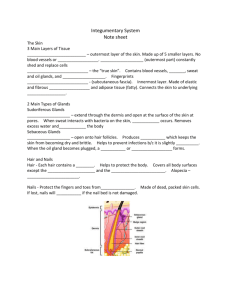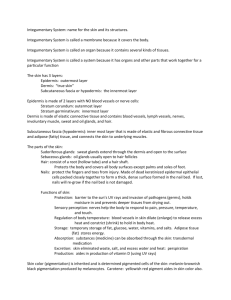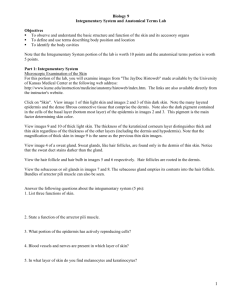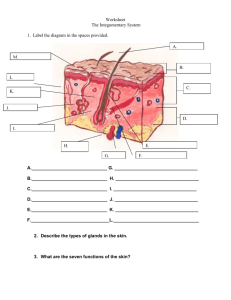Title: The Integumentary System Introduction: Skin and its accessory
advertisement
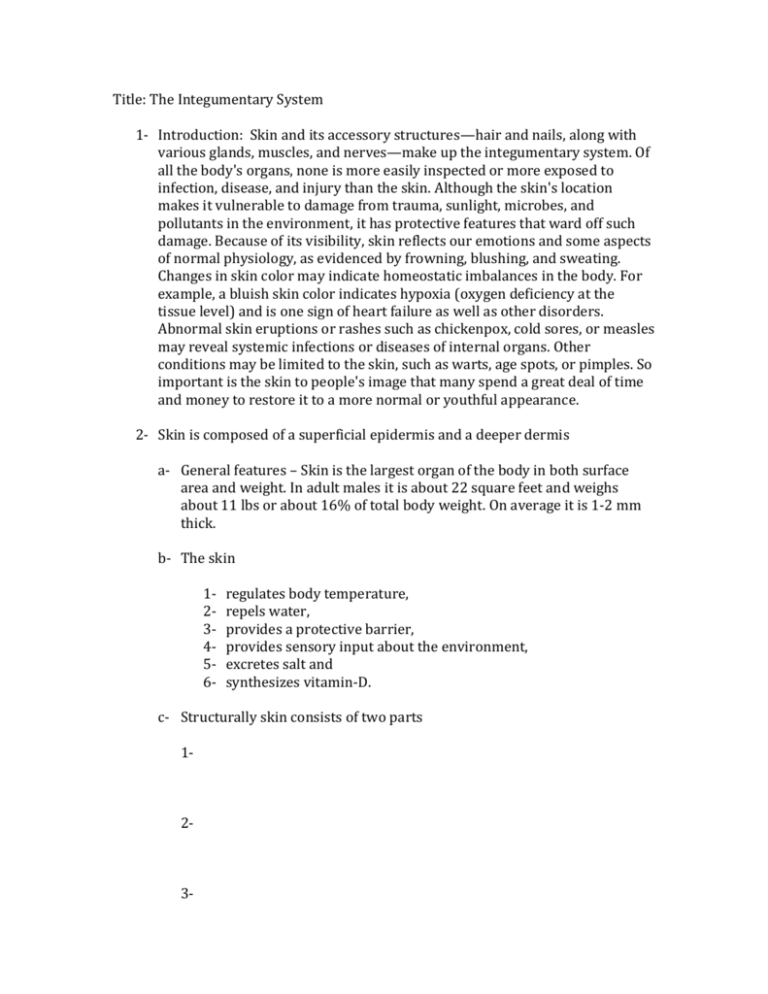
Title: The Integumentary System 1- Introduction: Skin and its accessory structures—hair and nails, along with various glands, muscles, and nerves—make up the integumentary system. Of all the body's organs, none is more easily inspected or more exposed to infection, disease, and injury than the skin. Although the skin's location makes it vulnerable to damage from trauma, sunlight, microbes, and pollutants in the environment, it has protective features that ward off such damage. Because of its visibility, skin reflects our emotions and some aspects of normal physiology, as evidenced by frowning, blushing, and sweating. Changes in skin color may indicate homeostatic imbalances in the body. For example, a bluish skin color indicates hypoxia (oxygen deficiency at the tissue level) and is one sign of heart failure as well as other disorders. Abnormal skin eruptions or rashes such as chickenpox, cold sores, or measles may reveal systemic infections or diseases of internal organs. Other conditions may be limited to the skin, such as warts, age spots, or pimples. So important is the skin to people's image that many spend a great deal of time and money to restore it to a more normal or youthful appearance. 2- Skin is composed of a superficial epidermis and a deeper dermis a- General features – Skin is the largest organ of the body in both surface area and weight. In adult males it is about 22 square feet and weighs about 11 lbs or about 16% of total body weight. On average it is 1-2 mm thick. b- The skin 123456- regulates body temperature, repels water, provides a protective barrier, provides sensory input about the environment, excretes salt and synthesizes vitamin-D. c- Structurally skin consists of two parts 1- 2- 3- 3- Cells of the Epidermis – There are four types of cells found in the skin a- Keratinocytes – b- Melanocytes – c- Langerhans cells – d- Merkel cells – 4- Keratinization of the epidermis 5- The Dermis – The dermis contains blood vessels, hair follicles, nerves, sense receptors, blood vessels, lymph vessels and a variety of glands (sebaceous, sweat) Within the dermis are: a- Meissner Corpuscles – b- Free nerve endings c- Epidermal ridges – 1- Sweat glands located at the top of the ridge, produce sweat when pressure is applied to them. This is what causes fingerprints. The ridge pattern is unique to everyone and while it gets larger throughout life the pattern remains the same. 6- Anatomy of Hair a- Hair is present on all surfaces except the palms of the hands and the plantar surface of the feet. In humans it is most widely distributed along the scalp, the brow ridge (eyebrows), axillae (armpits) and external genitalia b- Hair is a hallmark of mammals – All Mammals have hair c- Hair is composed of a column of dead keratinized cells held together by protein 1- Shaft – 2- The root 3- Follicle – a- Around the bulb are sebaceous glands (oil glands) which help to waterproof the hair and make it greasy. The arrector pili muscle located here is what we associate with goose bumps. 4- Hair usually grows for 2-6 years and then rests for 3 months. About 85% of the hair we see on the scalp is in the growth phase 5- Visible hair – 6- Hair color –



